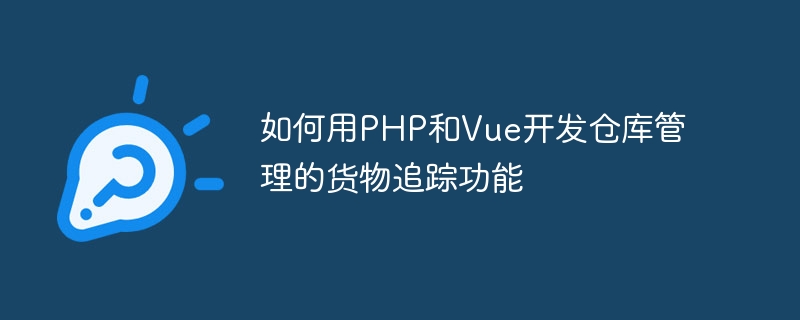如何用PHP和Vue開發倉庫管理的貨物追蹤功能
- WBOYWBOYWBOYWBOYWBOYWBOYWBOYWBOYWBOYWBOYWBOYWBOYWB原創
- 2023-09-24 08:57:231497瀏覽

如何用PHP和Vue開發倉庫管理的貨物追蹤功能
#引言:
隨著電子商務的快速發展,倉庫管理成為了一個非常重要的環節。為了提高倉庫管理的效率和準確性,開發一套貨物追蹤系統十分必要。本文將介紹如何使用PHP和Vue來開發倉庫管理的貨物追蹤功能,並給出具體的程式碼範例。
一、技術準備
在開始開發之前,我們需要準備好以下技術與工具:
- PHP:伺服器端程式語言
- Vue:用於建立使用者介面的JavaScript框架
- MySQL:用於保存資料的關聯式資料庫
- XAMPP:整合了Apache、MySQL和PHP的開發環境
#二、資料庫設計
在開始寫程式碼之前,我們需要設計好資料庫結構。考慮到倉庫管理的需要,我們需要建立以下幾張表:
- 貨物表:儲存貨物的信息,包括貨物ID、名稱、描述等欄位
- 倉庫表:儲存倉庫的信息,包括倉庫ID、名稱、地址等欄位
- 貨物倉庫關聯表:建立貨物和倉庫之間的關聯,儲存貨物在每個倉庫的數量、入庫時間等資訊
三、後端開發
-
建立資料庫連線
我們首先需要在PHP中建立與資料庫的連線。可以使用mysqli擴充庫提供的功能來實現:$servername = "localhost"; $username = "root"; $password = ""; $dbname = "warehouse_management"; // 创建数据库连接 $conn = new mysqli($servername, $username, $password, $dbname); // 检查连接是否成功 if ($conn->connect_error) { die("连接数据库失败: " . $conn->connect_error); } - 建立API介面
我們需要建立一系列API接口,用於處理前端發送過來的請求並傳回對應的資料。以下為一些常用的API介面範例: -
取得所有倉庫資訊:
$app->get('/warehouses', function () use ($app, $conn) { $sql = "SELECT * FROM warehouses"; $result = $conn->query($sql); $warehouses = array(); if ($result->num_rows > 0) { while($row = $result->fetch_assoc()) { $warehouses[] = $row; } } $app->response->headers->set('Content-Type', 'application/json'); echo json_encode($warehouses); });
-
取得指定倉庫的貨物資訊:
$app->get('/warehouses/:id/goods', function ($id) use ($app, $conn) { $sql = "SELECT * FROM goods_warehouses WHERE warehouse_id = $id"; $result = $conn->query($sql); $goods = array(); if ($result->num_rows > 0) { while($row = $result->fetch_assoc()) { $goods[] = $row; } } $app->response->headers->set('Content-Type', 'application/json'); echo json_encode($goods); }); -
新增貨物到指定倉庫:
$app->post('/warehouses/:id/goods', function ($id) use ($app, $conn) { $request = json_decode($app->request->getBody()); $name = $request->name; $description = $request->description; $quantity = $request->quantity; $date = date('Y-m-d H:i:s'); $sql = "INSERT INTO goods_warehouses (warehouse_id, name, description, quantity, date) VALUES ($id, '$name', '$description', $quantity, '$date')"; if ($conn->query($sql) === TRUE) { $response = array('status' => 'success'); } else { $response = array('status' => 'error', 'message' => $conn->error); } $app->response->headers->set('Content-Type', 'application/json'); echo json_encode($response); }); -
#更新貨物的數量:
$app->put('/goods/:id/quantity', function ($id) use ($app, $conn) { $quantity = json_decode($app->request->getBody()); $sql = "UPDATE goods_warehouses SET quantity = $quantity WHERE id = $id"; if ($conn->query($sql) === TRUE) { $response = array('status' => 'success'); } else { $response = array('status' => 'error', 'message' => $conn->error); } $app->response->headers->set('Content-Type', 'application/json'); echo json_encode($response); });
四、前端開發
-
創建Vue應用
我們需要使用Vue來建立使用者介面。首先需要在HTML中引入Vue庫,並建立Vue實例:<!DOCTYPE html> <html lang="en"> <head> <meta charset="UTF-8"> <title>仓库管理系统</title> <script src="https://cdn.jsdelivr.net/npm/vue/dist/vue.js"></script> </head> <body> <div id="app"> <!-- 在这里编写Vue模板代码 --> </div> <script src="js/app.js"></script> </body> </html> - 發送API請求
我們需要在Vue實例中傳送API請求,並處理傳回的資料。以下為一些常用的程式碼範例: -
取得所有倉庫資訊:
var app = new Vue({ el: '#app', data: { warehouses: [] }, mounted() { axios.get('/api/warehouses') .then(response => { this.warehouses = response.data; }) .catch(error => { console.log(error); }); } });
-
#取得指定倉庫的貨物資訊:
var app = new Vue({ el: '#app', data: { goods: [] }, mounted() { var id = 1; // 仓库ID axios.get('/api/warehouses/' + id + '/goods') .then(response => { this.goods = response.data; }) .catch(error => { console.log(error); }); } }); -
新增貨物到指定倉庫:
var app = new Vue({ el: '#app', data: { name: '', description: '', quantity: '' }, methods: { addGoods() { var id = 1; // 仓库ID axios.post('/api/warehouses/' + id + '/goods', { name: this.name, description: this.description, quantity: this.quantity }) .then(response => { console.log(response.data); }) .catch(error => { console.log(error); }); } } }); -
#更新貨物的數量:
var app = new Vue({ el: '#app', data: { goodsId: '', quantity: '' }, methods: { updateQuantity() { axios.put('/api/goods/' + this.goodsId + '/quantity', this.quantity) .then(response => { console.log(response.data); }) .catch(error => { console.log(error); }); } } });
透過使用PHP和Vue開發,我們可以輕鬆實現倉庫管理的貨物追蹤功能。 PHP提供了與資料庫互動的能力,Vue則可以幫助我們建立使用者介面並傳送API請求。本文給了一些具體的程式碼範例,希望對你的開發工作有所幫助。祝你開發愉快!
以上是如何用PHP和Vue開發倉庫管理的貨物追蹤功能的詳細內容。更多資訊請關注PHP中文網其他相關文章!
陳述:
本文內容由網友自願投稿,版權歸原作者所有。本站不承擔相應的法律責任。如發現涉嫌抄襲或侵權的內容,請聯絡admin@php.cn

